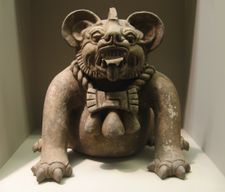فن جنائزي

الفن الجنائزي Funerary art، هو أي تشكيل أو قطعة فنية موضوعة، أو مستودع لرفات الميت. يشمل المصطلح أيضاً القبور الفارغة، النصب التذكارية المشابهة للقبور والتي لا تحتوي على رفات بشرية؛ النصب التذكارية الجماعية للموتى (مثل النصب التذكارية للحروب)، والتي قد تحتوي أو لا تحتوي على رفات بشرية.
. . . . . . . . . . . . . . . . . . . . . . . . . . . . . . . . . . . . . . . . . . . . . . . . . . . . . . . . . . . . . . . . . . . . . . . . . . . . . . . . . . . . . . . . . . . . . . . . . . . . . . . . . . . . . . . . . . . . . . . . . . . . . . . . . . . . . . . . . . . . . . . . . . . . . . . . . . . . . . . . . . . . . . . .
التاريخ
قبل التاريخ
مصر القديمة والنوبة
كانت قطع من الأثاث توضع في العديد من مقابر الأفراد خلال عصر [[[الأسرة المصرية الثامنة عشر|الأسرتين الثامنة عشرة]] والتاسعة عشرة كى يستخدمها المتوفى في العالم الآخر.
اليونان القديمة

الإتروسكيون
استعمل الإتروسكيون الحجر والطين النضيج (تراكوتا) والمعدن لإنتاج منحوتاتهم. ومعظمها سخر لغايات دينية كالمدافن والنواميس والمرمدات (جرار حفظ رماد الموتى) والنصب المقدمة نذوراً أو التي تزين المعابد. وقد عثر على مرمدات فخارية ذات أغطية برونزية ومرمدات على هيئة كوخ ريفي وعلى أقنعة جنازية تحمل زخارف بسيطة، كما عثر على مباخر وجرار وكؤوس فخارية ومعدنية نقشت عليها شخوص أو حيوانات أليفة أو متخيلة أو نقوش تمثل مشهداً أسرياً، وتعود جميعها إلى حقبة ما قبل التاريخ الأخيرة (القرنين 10 و9 ق.م). أو القرنين الثامن والسابع ق.م ويبدو الأسلوب الإغريقي القديم بتفصيلاته القاسية واضحاً في المنحوتات القديمة كالقنطور الذي يحرس أحد مدافن مدينة فولتشي، وهو تمثال لمخلوق خرافي نصفه رجل ونصفه حصان (نحو 600 ق.م)، كما يظهر التأثير الإيوني اللاحق في تمثال الرجل والمرأة المتكئين على أريكة من الطين النضيج على غطاء ناووس في مدينة كايري نحو (500ق.م)، أما أكثر المنحوتات إثارة فهي تماثيل الآلهة المصنوعة من الطين النضيج بالحجم الطبيعي كتمثال أبولو وهرمس (مركوري) وهرقل وغيرهم في سقف معبد في مدينة فيي أوائل القرن الخامس ق.م أما المنحوتات التي تعود إلى العصر الهليني في معبد ببرغي (نحو 450 ق.م) وهي تمثل صراعاً بين أحد الآلهة وأحد العمالقة في حضور تينية ومنيرفة، وقد عثر في بعض الأضرحة التي تعود إلى العصر الهليني، على مئات النواويس الحجرية والمرمدات المنحوتة من الحجر المسامي أو الكلسي أو الطين النضيج أو المصنوعة من الفخار وعليها ألواح جانبية منقوشة بنحت نافر قليلاً، ولها أغطية تحمل نحتاً نصف بارز يتنوع ما بين أشكال هندسية غير متقنة ونماذج واقعية وفق الأسلوب الإغريقي الهليني، ولاسيما المنحوتات المتأخرة منها. وقد مهد هذا النوع من النحت لظهور الأسلوب الروماني الواقعي فيما بعد.
روما القديمة
الصين
| 不享遐年 | She did not enjoy old age |
| 以永春秋 | With long years |
| 往而不返 | She is gone and will not return, |
| 濳淪天幽 | She has sunken deep into the great darkness. |
| 嗚呼哀哉 | Alas, sorrowful indeed! |
| 凡席虛設 | Tables and mats are set but unused, |
| 幃帳空陳 | The curtains and canopies have been put out in vain. |
| 品物猶在 | Her things are still there, |
| 不見其人 | We do not see her person. |
| 魂氣飄飄 | Her ghost drifts about. |
| 焉所安神 | How could we pacify her spirit? |
كوريا

اليابان
. . . . . . . . . . . . . . . . . . . . . . . . . . . . . . . . . . . . . . . . . . . . . . . . . . . . . . . . . . . . . . . . . . . . . . . . . . . . . . . . . . . . . . . . . . . . . . . . . . . . . . . . . . . . . . . . . . . . . . . . . . . . . . . . . . . . . . . . . . . . . . . . . . . . . . . . . . . . . . . . . . . . . . . .
الأمريكتين

المجتمعات التقليدية

المسيحية

الإسلام
انظر أيضاً
- آثار الكنيسة
- آثار الكنيسة الإنگليزية
- Ossuaries
- Cadaver tomb
- Death in Norse paganism
- List of mausolea
- قائمة القبور والأضرحة
- قائمة القبور الپاپوية الباقية












